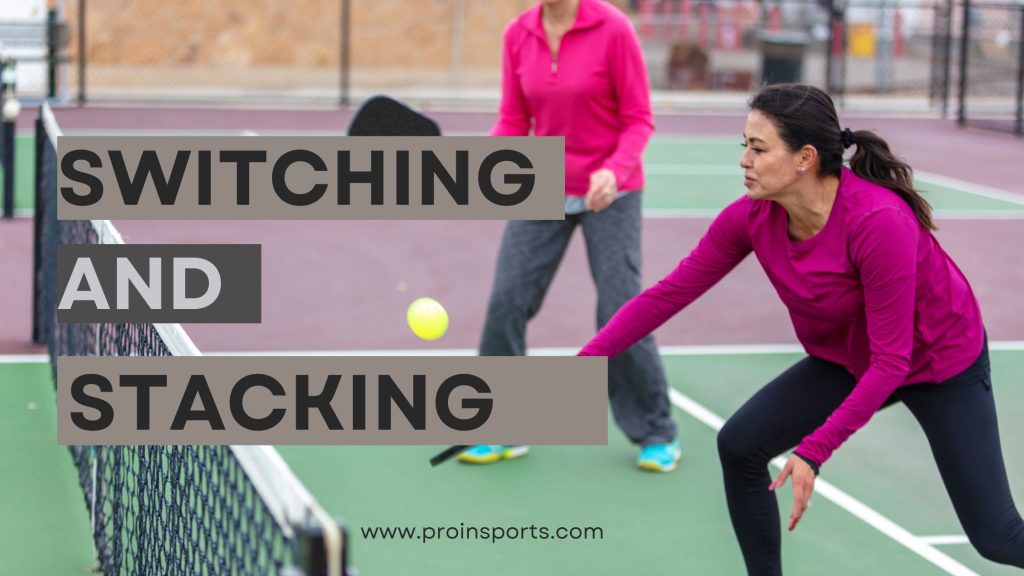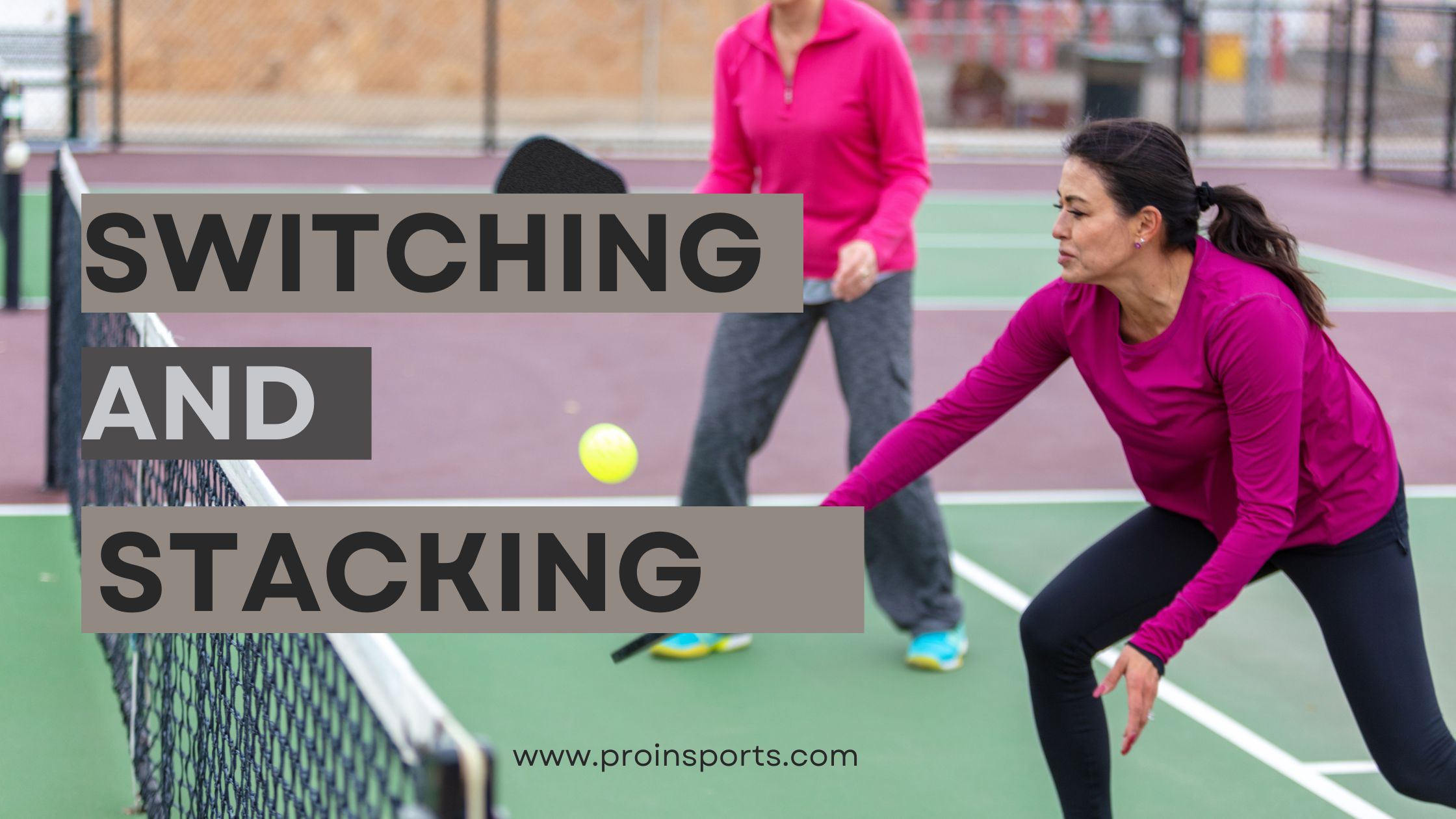Playing pickleball is an exciting, fast-paced game requiring skill and strategy. Whether you’re a beginner or a seasoned veteran, knowing can you switch hands in pickleball is essential to ensure you’re playing at your best.
In this blog, we’ll discuss the importance of switching sides in pickleball, When Do You Switch Sides in Pickleball and the different strategies you can use to ensure you’re always playing your best.

What is Stacking and switching
“Switch Sides” in Pickleball refers to changing the opposite side of the court that a player is playing on. This typically occurs after a set number of points have been scored or at the end of a game. The purpose of switching sides is to ensure fairness and balance the physical exertion of the players.
Switching and stacking are both relatable terms, but stacking means when playing doubles, Players from both teams line up on one side of the court when returning the serve. Afterwards, player can also move back to their original positions.
General Rule for When Do You Switch Sides in Pickleball
As a pickleball player, one of the most important rules to remember is when you switch sides in pickleball. This ensures fair play for both players to have a chance to score points.
The general rule for switching sides is when a player on the serving team scores 11 points, the player can also switch unless a point is scored. This ensures a balance of points and allows the other team to win.
Switching and stacking ensure you’re standing in the right positions on the court. The players should be on the side they’re serving from and stay on that side of the court. This prevents confusion and helps to make sure that the gameplay is fair.
It’s also important to note that in pickleball, the players cannot switch sides during a game. Once a side has been chosen, it must remain that way until the end of the game. This prevents players from changing positions in the middle of a match, which could affect the game’s outcome.
Factors that Affect When to Switch Sides
The right time to switch can have a major impact on the outcome of the match and can determine the winner. Here are some key factors to consider to make sure you switch sides at the right time.
Number of Players
The number of players in a pickleball match will affect when it is best to switch. When playing in Singles players can switch after every 7 or 5 points. However, when playing in doubles it is best to switch after every 11 points. This ensures that everyone gets a chance to be the server and to receive from different angles.
Level of Play
Another important factor to consider when determining when to switch sides in pickleball is the level of play. For example, switching sides’ rules may differ in tournaments than in casual play. The level of play decide when serving team do not alternate .
Skill Level of Players
The skill level of the players is also important to consider when determining when to switch sides. If the players are evenly matched, then switching sides after every 11 points is recommended. But if the skill level is unevenly matched, it is best to switch sides more often. This way, the weaker player can have a chance to receive the serve from different angles and to be the server more often.
Length of Match
The length of the match is another factor that affects when sides are switched. For example, in a best-of three games sides may be switched after every 11 points, while in a best-of-5 match, the switch may occur after every 21 points. The switch may also be affected by time constraints, such as when a match must be completed in a set amount of time.
Strategies for Switching Sides in Pickleball
If you’ve been playing pickleball for a while, you’ve likely become accustomed to playing on one side of the court. But, sometimes, it’s necessary to switch sides of the court to adjust to the opponent’s playing style and to gain an advantage. Here are three strategies for switching sides in pickleball.
Rotate in a Clockwise Direction
Switching sides in pickleball is easier when you rotate in a clockwise direction. This helps ensure that both players are in their opposite court corner. When switching sides, both players should move around the circle clockwise.
Move Quickly During the Switch
It’s important to move quickly during the switch to ensure you’re not giving your opponent time to prepare for their next shot. You may gain an advantage by catching your opponent off guard if you can move quickly.
Set Up your Strategy
You should also take advantage of the time to set up your strategy when switching sides. This might mean taking a few seconds to plan your shots or discussing strategy with your partner. You can also use this time to practice your serves before going back to your original positions. This can help you develop better game sense and prepare for when you hit return serves.
Switching sides in pickleball can be a great way to gain an advantage over your opponent.
Advantages of Switching in Pickleball:
Disadvantages
Hand Signals
Pickleball is an incredibly popular sports for people of all ages because it is easy to learn and fun to play, as even younger kids can join in on the game.
However, there are some important rules to remember when playing pickleball – such as hand signals during switching as they help keep the game running smoothly and ensure everyone is on the same page.
- First, it’s important to understand the concept of switching in pickleball. In a match, players will switch sides after each attempt. This means that the players on the court at the start of the game will switch places with the teammate on the sidelines. So everyone gets right serves first, and no one gets overly tired from standing in the same spot for too long.
- Before a game begins, both teams must agree on which signal to indicate when the switch is happening. Generally, the most common signal is to raise one’s index and middle fingers in the air.
- It’s also important everyone is paying attention and communicating when it comes to switching. If a player is too slow or not paying attention, they may miss the signal, and the switch will not happen. This can lead to confusion and delays in the court,
Tips to remember while switching Sides in Pickleball
Here are some points to remember when it comes to serve and return shots of pickleball:
Proper Form:
It’s important to remember the basics when it comes to serve and return shots of pickleball. Proper form is essential for success. You should have your feet shoulder-width apart, your non-dominant foot slightly forward, your arms relaxed, and your dominant hand slightly cupped.
Footwork:
You should practice your footwork to move quickly and efficiently in the middle of a point.
Arm Position:
Your arms should be in the proper position during service. Ensure your arms are held up to extend them for a powerful serve and return.
Grip:
The grip of your paddle is very important to practice your grip so that you can get the most power from your shots.
Timing:
Timing is critical when it comes to serve and return shots. You need to be able to hit the ball at the right moment, so it lands in the right spot.
Spin:
Adding spin to your shots can be a great way to throw off your opponents. Practice your spin shots to get the most out of them.
By following these points to remember when it comes to serve and return shots of pickleball, you’ll be well on your way to becoming a great pickleball player. Good luck!
Frequently Asked Questions
Final Verdict
switching sides in pickleball is an element of surprise that helps to even out any potential court advantages. It encourages players to use different shots and angles while improving their fitness level. It can also help prevent boredom, giving players something new to focus on. Furthermore, by changing courts between sets, players can reset their minds and energy levels for their defend.
Finally, switching players often make the game more interesting and dynamic when playing doubles. Switching sides in pickleball offers several benefits that should not be overlooked.
